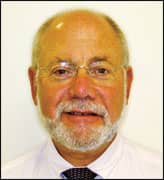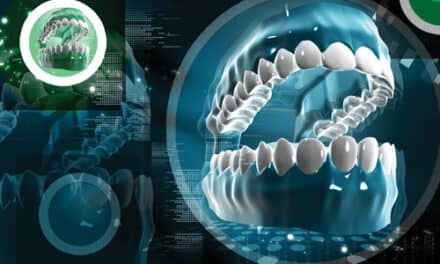by Dipak Chudasama, BDS, MSC, MORTH RCS, and Laurance Jerrold, DDS, JD, ABO
Contemporary archwire selection criteria for starting and finishing archwires
 |
 |
| Dipak Chudasama, BDS, MSC, MORTH RCS | Laurance Jerrold, DDS, JD, ABO |
The choice of archwire for each stage of orthodontics is based on the properties of the archwire, coupled with the goals for that stage of treatment. “Starting archwires” address the goals of leveling, aligning, and rotating (LAR) the dentition. There may be a number of other goals—customization of the archform, dealing with the transverse dimension, control of the curve of Spee, and opening or closing the bite, to name a few—but these are most often accomplished after LAR has been completed.
Initial Wires
An ideal initial wire should have low stiffness and excellent range, and should be superelastic. Superelasticity and thermal activity are beneficial properties during the initial phase. A number of studies have tested the clinical effectiveness of superelastic wires in respect to the correction of irregularity of the anterior teeth, and it is interesting to note that some of these studies have failed to demonstrate a clear advantage of modern archwires.1–3 The current popular choice for an initial archwire among clinicians is the preformed NiTi superelastic archwire or the heat-activated copper NiTi archwire. Less popular but still used quite often are braided stainless steel archwires.
As to which archwire is more effective, a clinical trial by O’Brien et al1 showed no significant difference in contact point alignment between Nitinol and Titanol archwires over a period just greater than a month. Another study by West et al2 that compared 0.0155-inch multistrand stainless steel round wire with an 0.014-inch NiTi superelastic wire noted that the superelastic wire gave improved alignment. However, this result was seen in the lower labial segment only. Evans et al3 compared three aligning archwires: a 0.016- x 0.022-inch active martensitic wire, a 0.016- x 0.022-inch active martensitic wire, and a 0.015-inch multistrand wire. Statistical analysis of the data found no difference between the performances of the three wires. When adverse effects of aligning archwires are taken into consideration, Weilland4 has shown that there is an increased tendency for the occurrence of root resorption when superelastic archwires are used compared to stainless steel archwires.
Recently, there has been an increase in the development of aesthetic brackets and archwires, but there are few studies in the literature that demonstrate or quantify the effectiveness of tooth-colored or clear archwires. A recent introduction into the market, the BioMers translucent archwire,11 has been developed especially as an initial leveling and aligning wire. The initial results from clinical trials performed at the Jacksonville University School of Orthodontics using these wires demonstrated excellent results during the leveling and aligning phases.
Finishing Wires
Detailing the occlusion with finishing archwires may require correction in all three planes of space. It is important not to lose either the correction or the space closure achieved during the leveling and aligning phase of treatment. Hence, the choice of a finishing archwire depends on the specifics that need to be addressed. It is important to note that posterior settling is usually necessary because of improper bracket placement that has resulted in less than full posterior dental intercuspation.
If settling is required, one technique is to use either a braided stainless steel or a small-gauge NiTi archwire with vertical elastics (serpentine, box, or triangular with or without a directional component) as needed to finalize the intercuspation. One problem is that this technique is generally reciprocal and what may be called for is settling of one arch into the other as opposed to both into each other. If this is the case, then the finishing wire for the “correct arch” should be constructed of heavy-enough stainless steel (0.18 x 0.25 at a minimum) so that it will not be overpowered by the elastics employed.
 |
| Figure 1: This archwire testing system allows for anterior and posterior arches to be tested. |
Another technique to achieve posterior settling is to convert the full arch to upper and/or lower anterior sectional arches to maintain the stability of the anterior teeth while removing the posterior sections of the archwire to allow the posterior dentition to physiologically settle. This may be done in both arches or only in one as the clinical needs dictate.
If you believe that all of the brackets are ideally positioned on each tooth, then finishing can be accomplished using full-sized stainless steel archwires. Presumably, in these cases settling is not necessary. By filling the slot, you can take advantage of the built-in pretorqued and preangulated bracket prescriptions employed by the clinician.
Archwire Testing Methods
To determine the efficacy of any new orthodontic product, various tests must be conducted. Although in vitro studies provide some insight into the properties of any material used in orthodontics, these studies don’t offer a definitive look at how the product will act in vivo. When studying an archwire, it is relatively easy to determine its mechanical properties; but this information ultimately falls short of explaining how the archwire will be able to move teeth.
It is because of the above reasons that a novel apparatus (Figure 1) to test a curved segment of wire was constructed at the School of Orthodontics at Jacksonville University and forms the basis for comparative testing within the traditional ADA specifications.11
Beginning or ending, the wire you use is merely a tool. It is the vision, experience, and expertise of the artisan employing the tool that is critical to achieving a good orthodontic outcome.
Dipak Chudasama, BDS, MSC, MORTH RCS, is an assistant professor and the director of research at the Jacksonville University School of Orthodontics. He can be reached at
Laurance Jerrold, DDS, JD, ABO, is the dean and program director at the Jacksonville University School of Orthodontics. He can be contacted at
References
- O¹Brien K, Lewis D, Shaw W, Coombe E. A clinical trial of aligning archwires. Eur J Orthod. 1990;12:380-384.
- West AE, Jones ML, Newcombe RG. Multiflex versus superelastic: a randomised clinical trial of the tooth alignment ability of initial archwires. Am J Orthod Dentofacial Orthop. 1995;108:464-471.
- Evans TJW, Jones ML, Newcombe RG. Clinical comparison and performance perspective of three aligning archwires. Am J Orthod and Dentofacial Orthop. 1998;114:32-39
- Weiland F. Constant versus dissipating forces in orthodontics: the effect on initial tooth movement and root resorption. 2003;25(4):335-342.
- Kusy RP. Nitinol alloys: So, who¹s on first? Am J Orthod Dentofac Orthop (Letters to the Editor). 1991;100:25A-26A.
- Burstone CJ, Qin B, Morton JY. Chinese Ni-Ti wire: a new orthodontic alloy. Am J Orthod. 1985;87:445-452.
- Miura F, Mogi M, Ohura Y, Hamanaka H. The superelastic properties of the Japanese Ni-Ti alloy wire for use in orthodontics. Am J Orthod Dentofacial Orthop. 1986;90:1-10.
- Santoro M, Nicolay OF, Cangialosi TJ. Pseudoelasticity and thermoelasticity of nickel-titanium alloys: a clinically oriented review. Part I. Temperature transitional ranges. Am J Orthod Dentofacial Orthop. 2001;119:587-593.
- Santoro M, Nicolay OF, Cangialosi TJ. Pseudoelasticity and thermoelasticity of nickel-titanium alloys: a clinically oriented review. Part II. Deactivation forces. Am J Orthod Dentofacial Orthop. 2001;119:594-603.
- Santoro M, Beshers DN. Nickel-titanium alloy: stress-related temperature transitional range. Am J Orthod Dentofacial Orthop. 2000;118:685-692.
- American National Standard/American Dental Association Specification No. 32: Orthodontic Wires. Chicago, III: American Dental Association; 2000.










